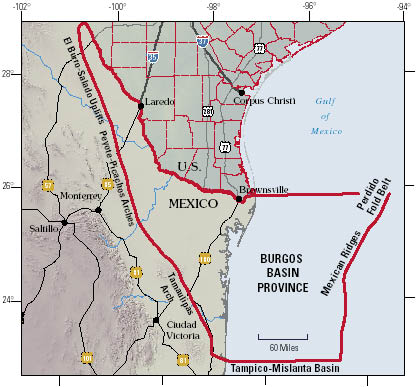World Energy Assessment Project Fact Sheet
U.S. Department of the Interior
U.S. Geological Survey
Fact Sheet 2004–3007
February 2004
Using a geology-based assessment methodology, the U.S. Geological Survey estimated a mean of 12.9 trillion cubic feet of undiscovered nonassociated gas, a mean of 6.2 billion barrels of undiscovered oil (with 7.4 trillion cubic feet of associated gas), and a mean of 0.52 billion barrels of undiscovered natural gas liquids in the Burgos Basin Province of northeastern Mexico.
The U.S. Geological Survey (USGS) recently completed an assessment of the undiscovered oil and gas potential of the Burgos Basin Province of northeastern Mexico (fig. 1) in order to understand the potential contribution of Mexican resources to North American gas supply. The USGS Burgos Basin Province, as defined for this assessment, is bounded on the north by the U.S.-Mexico border, on the west by the Tamaulipas, Peyote-Picachos, and El Burro-Salado uplifts, on the south by the Tampico-Mislanta Basin, and on the east by the Mexican Ridges and part of the Perdido fold belt in the deep-water Gulf of Mexico. The assessment of the Burgos Basin Province is based on the geologic elements of the Total Petroleum System (TPS) defined in the province, including hydrocarbon source rocks (source-rock maturation, and hydrocarbon generation and migration), reservoir rocks (sequence stratigraphy and petrophysical properties), and hydrocarbon traps (trap formation and timing). By using this geologic framework, the USGS defined one composite TPS and five Assessment Units (AU) within the TPS, and quantitatively estimated the undiscovered oil and gas resources within the five AUs (table 1).

Figure 1. Burgos Basin Province of northeastern Mexico.
The USGS assessed undiscovered conventional oil and gas resources in the Burgos Basin Province, exclusive of reserve growth. The USGS estimated a mean of 12.9 trillion cubic feet of nonassociated gas (TCFG), a mean of 6.2 billion barrels of oil (with 7.4 TCF of associated gas), and a mean total of 0.52 billion barrels of natural gas liquids for the five AUs (table 1).
Click on the table for a version that is high resolution.
The undiscovered nonassociated gas resource (gas in undiscovered gas fields) is assessed to be nearly all onshore in four assessment units; Upper Jurassic–Cretaceous Reservoirs AU, Wilcox Lobo Sandstones AU, Wilcox-Eocene Sandstones AU, and the Frio-Vicksburg Sandstones AU. About half (6.6 TCFG) of the total mean undiscovered nonassociated gas (12.9 TCFG) is estimated to be in the Frio-Vicksburg Sandstones AU (table 1). The Wilcox-Eocene Sandstones AU is estimated to contain a mean of about 39 TCFG, and the Wilcox Lobo Sandstones AU about 1.6 TCFG (table 1). The remainder of the nonassociated gas is in the Upper Jurassic-Cretaceous Reservoirs AU and the Eocene-Miocene Sandstones AU.
The mean total volumes of undiscovered oil and associated gas (gas in undiscovered oil fields) were nearly all in the offshore part of the Eocene-Miocene Sandstones AU (table 1). The geologic model for the Eocene-Miocene Sandstones AU in part was based on recent discoveries along the Perdido fold belt in deep water on the U.S. side of the border. These discoveries are reputed to be in Eocene sandstone reservoirs possibly charged with Upper Jurassic- or Cretaceous-sourced oil and gas. Traps are associated with compressional structures of the Perdido fold belt. A similar geologic model is envisioned for the assessment of undiscovered oil and gas resources in the Mexican Ridges of the Burgos Basin Province immediately south of the Perdido fold belt. This assessment of oil and associated gas resource in the Eocene-Miocene Sandstones AU is highly uncertain given the lack of data in this part of the Burgos Basin Province.
Supporting geologic studies of the Composite Total Petroleum System and Assessment Units, and the methodology used in the Burgos Basin Province assessment, are being prepared. Assessment results are available at the USGS Central Energy Team website: http://energy.cr.usgs.gov/oilgas/.
Christopher J. Schenk (Task Leader, schenk@usgs.gov); Thomas S. Ahlbrandt, Ronald R. Charpentier, Donald L. Gautier, Mitchell E. Henry, Timothy R. Klett, Richard M. Pollastro, Gregory F. Ulmishek, and Jean N. Weaver.
Document Accessibility: Adobe Systems Incorporated has information about PDFs and the visually impaired. This information provides tools to help make PDF files accessible. These tools convert Adobe PDF documents into HTML or ASCII text, which then can be read by a number of common screen-reading programs that synthesize text as audible speech. In addition, an accessible version of Acrobat Reader 6.0, which contains support for screen readers, is available. These tools and the accessible reader may be obtained free from Adobe at Adobe Access.
| AccessibilityFOIAPrivacyPolicies and Notices | |
| |
|